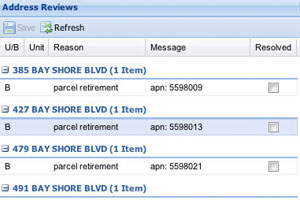 In Part 1 of this series, I described the context and motivation behind the development of our Enterprise Addressing System, a complete master address repository, address creation & maintenance system, and address query & validation solution.
In Part 1 of this series, I described the context and motivation behind the development of our Enterprise Addressing System, a complete master address repository, address creation & maintenance system, and address query & validation solution.
To reiterate:
- Addresses are critical data
- Its a challenge to keep address system up to date
- Its almost impossible to keep systems synced across departments
- You can’t ask departmental staff to manage addresses using traditional desktop GIS tools because the technology’s too challenging and too expensive
- The top priorities for any solution need to be ease-of-use, transparent address entry/validation/maintenance and web-based access
In this second post of the three part series, I want to talk about address maintenance workflows and the use of open standards.
Make Enterprise Address Maintenance and Management Simple
The importance of ease-of-use applies to address maintenance, just as it does for address querying or address entry. For example, if an address isn’t in the system, is it because of the spelling or a transposition of numbers? Or is because the address doesn’t exit or needs to be updated in some way.
In any of these cases, EAS offers a straightforward, consistent way of requesting an address update through a validated workflow. So anybody who has account privileges to edit addresses can say, “I’d like to make this change to this address,” or, “I’d like to add this address,” or, “This address doesn’t exist anymore and should be replaced with this new address.” The EAS processes this as a change request and the information is automatically passed on to someone who has authorization to review and approve that request. If it is approved, great, it goes into the system. If it isn’t approved it’s sent back to the requester with a message explaining why the address change request wasn’t approved and the additional information or changes that need to be made before it can be approved. The workflow is very structured and controlled but highly streamlined and very easy to implement.
The address maintenance workflow represents what I think is fundamentally key about the EAS. It turns a difficult job that happens everyday across many departments into a significantly easier task if you’re just an address consumer and an order of magnitude easier to manage if you’re an address creator or an address approver.
It is important to note two additional things about EAS: It is Open Standards-based and Open Source.
Open Standards Addressing Solutions Enables Cross Application Integration
The Enterprise is standards based. It is compliant with the recently FGDC approved standard for managing address and ensures that every single address point can be resolved back to a street or a parcel. So this gives you a consistent way, standards-based way of managing addresses that can be integrated with other systems that rely on addresses.
The classic example is dispatching systems. You want your fire department and your police department to go to the right place. So it is essential your dispatching system comes from and integrates with some kind of authoritative address system.
And, as anyone who’s worked with E911 systems knows, it’s pretty common to get a call that the system can’t automatically tie to an address. When this happens, dispatchers often insert a new address into their E911 system.
This means there’s always a potential for the dispatch addressing database and the police/fire department addressing database to diverge. But using the EAS and standards-based data, the dispatcher can go ahead and add the address to their system for this mission critical task. A web service from the dispatching system could then communicate with the EAS and automatically submit an address change request that goes to through the same structured review process as any other address update request. This keeps these different mission critical systems in sync.
Permitting is another example of cross application integration using standards. You might not want to issue a permit if the building’s address doesn’t exist in the EAS or if it’s address is out of date or needs to be modified because you’re splitting a parcel. So the EAS is built to enable you to integrate with a legal document system such as permitting and match this against an address list. As a side note, the EAS-generated address list remembers lineage. So for example if you had a building that had an address of 610 Mission St back in the 1960s, but then that building was torn down and it was replaced by a building called 612 Mission Street, there’s still a way to link those two addresses to the same location.
Part III – Why Open Source Matter for an Enterprise Address Repository and Management System
In the final post in this blog series on the EAS I will talk about the advantages of delivering an addressing solution that is Open Source




